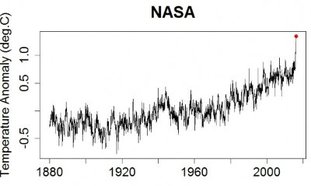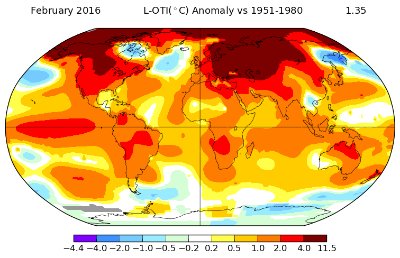Yes, we have just had the hottest February ever (and, wow, what a spike it was) and 2015 was another record warm year but it is enormously important that global warming advocates and climate scientists don’t overplay this.

Remember 1998? Remember the spike in temperatures that El Niño brought?
Then you must remember how that became the cherrypicked gold standard for climate change deniers and a decade of discussion and research into a “pause” in global warming that recent papers now suggest didn’t exist.
Communicators in science need to be very careful with the language around this current extraordinary event.
When 1998 was used as the starting point for claims about global cooling or a pause, the response of scientists and sensible folks in the climate change community was, look at the long-term trend, around 30 years.
Likewise, advocates for climate change science should not start spouting lines about the new normal now and pretty much bragging about this super hot month in the schoolyard saying, “see we told you so”, to climate change deniers. To do so would be to cherrypick.
This early, we should not be talking about a new normal, or even a step-change in climate – at least not yet. Climate change has certainly played an important role in the current record but on top of that we have just had a super El Niño. These are not frequent events. This is only the third that we know of on the instrumental record (82/83 and 97/98 were the other two) and they generally don’t come back for another 20 plus years.
In addition, there is a 40% chance that an El Niño event will be followed by a La Nina event or neutral conditions.
So, even if 2016 goes on to be a record year, which would not be unusual as often the second year is warmer than the year the El Niño started, it is much more likely the following years will fall away in terms of global average temperatures.
We will only know if this recent peak is a new normal or a step change in around five years time.
When 1998 was used as the starting point for claims about global cooling or a pause, the response of scientists and sensible folks in the climate change community was, look at the long-term trend, around 30 years.
Likewise, advocates for climate change science should not start spouting lines about the new normal now and pretty much bragging about this super hot month in the schoolyard saying, “see we told you so”, to climate change deniers. To do so would be to cherrypick.
This early, we should not be talking about a new normal, or even a step-change in climate – at least not yet. Climate change has certainly played an important role in the current record but on top of that we have just had a super El Niño. These are not frequent events. This is only the third that we know of on the instrumental record (82/83 and 97/98 were the other two) and they generally don’t come back for another 20 plus years.
In addition, there is a 40% chance that an El Niño event will be followed by a La Nina event or neutral conditions.
So, even if 2016 goes on to be a record year, which would not be unusual as often the second year is warmer than the year the El Niño started, it is much more likely the following years will fall away in terms of global average temperatures.
We will only know if this recent peak is a new normal or a step change in around five years time.

There was also a lot of noise recently when the entire Northern Hemisphere was above 1.5°C for a few days and even reached 2°C.
This event was important to note but again we need to be careful about how we play this.
There is an opportunity here for the equivocal breed of climate change denier, the one that claims climate change is not dangerous, to turn around and say, “we have experienced 2°C and nothing happened - it’s not that bad at all”.
These spikes are certainly warnings but if we want to be taken seriously as communicators in the field of climate change, it’s vital we keep our eye on the trend over time not the spike in the moment. Those spikes will be used to needle scientists in the future if we don’t put them in proper context.
This event was important to note but again we need to be careful about how we play this.
There is an opportunity here for the equivocal breed of climate change denier, the one that claims climate change is not dangerous, to turn around and say, “we have experienced 2°C and nothing happened - it’s not that bad at all”.
These spikes are certainly warnings but if we want to be taken seriously as communicators in the field of climate change, it’s vital we keep our eye on the trend over time not the spike in the moment. Those spikes will be used to needle scientists in the future if we don’t put them in proper context.